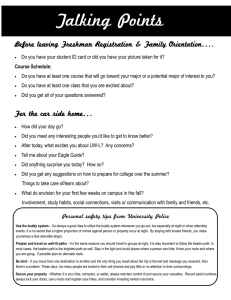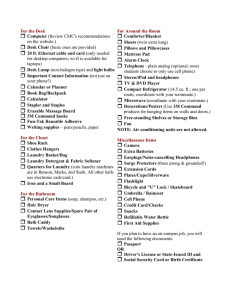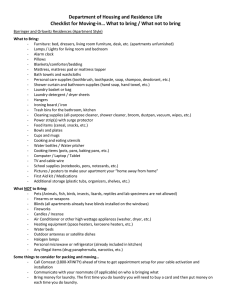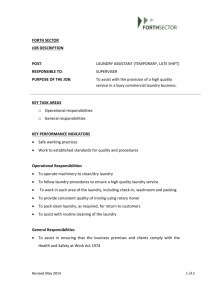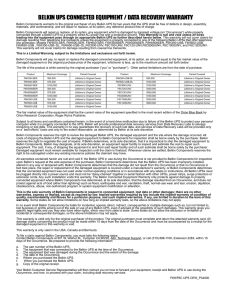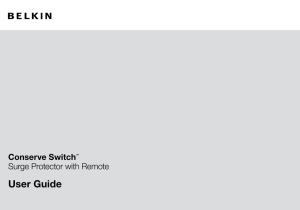4 February 2004
advertisement
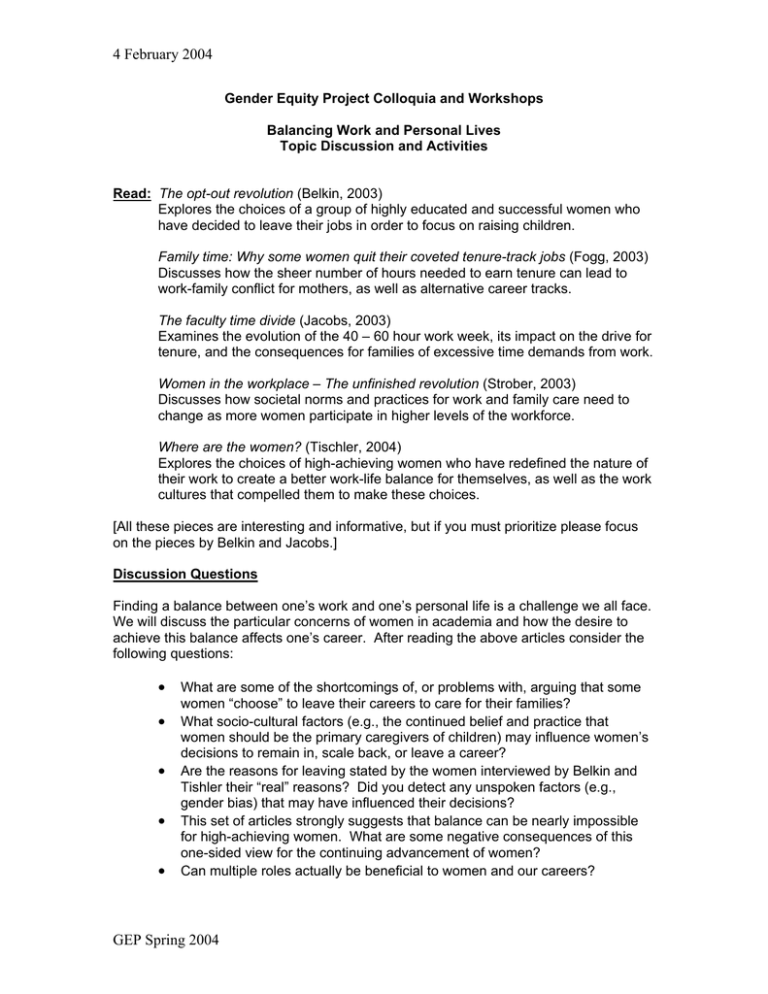
4 February 2004 Gender Equity Project Colloquia and Workshops Balancing Work and Personal Lives Topic Discussion and Activities Read: The opt-out revolution (Belkin, 2003) Explores the choices of a group of highly educated and successful women who have decided to leave their jobs in order to focus on raising children. Family time: Why some women quit their coveted tenure-track jobs (Fogg, 2003) Discusses how the sheer number of hours needed to earn tenure can lead to work-family conflict for mothers, as well as alternative career tracks. The faculty time divide (Jacobs, 2003) Examines the evolution of the 40 – 60 hour work week, its impact on the drive for tenure, and the consequences for families of excessive time demands from work. Women in the workplace – The unfinished revolution (Strober, 2003) Discusses how societal norms and practices for work and family care need to change as more women participate in higher levels of the workforce. Where are the women? (Tischler, 2004) Explores the choices of high-achieving women who have redefined the nature of their work to create a better work-life balance for themselves, as well as the work cultures that compelled them to make these choices. [All these pieces are interesting and informative, but if you must prioritize please focus on the pieces by Belkin and Jacobs.] Discussion Questions Finding a balance between one’s work and one’s personal life is a challenge we all face. We will discuss the particular concerns of women in academia and how the desire to achieve this balance affects one’s career. After reading the above articles consider the following questions: • • • • • What are some of the shortcomings of, or problems with, arguing that some women “choose” to leave their careers to care for their families? What socio-cultural factors (e.g., the continued belief and practice that women should be the primary caregivers of children) may influence women’s decisions to remain in, scale back, or leave a career? Are the reasons for leaving stated by the women interviewed by Belkin and Tishler their “real” reasons? Did you detect any unspoken factors (e.g., gender bias) that may have influenced their decisions? This set of articles strongly suggests that balance can be nearly impossible for high-achieving women. What are some negative consequences of this one-sided view for the continuing advancement of women? Can multiple roles actually be beneficial to women and our careers? GEP Spring 2004 4 February 2004 Activity 1: Some academics find it difficult to balance the various aspects of their work and their personal lives. Although individuals "decide" every day how to spend their time, their decisions occur within institutional and societal contexts. Institutional norms influence and constrain decisions. For example, the ratio of time spent teaching to time spent on research differs by type of institution. Institutions help determine how much work is seen as necessary for success, what kinds of personal satisfactions are seen as important and legitimate, and provide (or fail to provide) resources for meeting people's varied needs. Think about some ways that Hunter College could help create an environment that is conducive to a work-life balance. Working in a group of three, generate at least one idea for concrete change at the institutional level that would help Hunter College faculty achieve greater balance between their personal lives and work. Your suggestion may address any aspect of personal life you feel is important. For example, if social interaction with like-minded individuals regardless of their field of study is important to you, you might suggest organizing a faculty club that provides the opportunity to socialize across disciplines. Be ambitious with your ideas, but try to make your suggestions as feasible as possible. Activity 2: Although time-management principles alone cannot create a better balance between work and life activities, they can help in working toward that balance. Several principles are at work here. One is to think deliberately about what you want. Another is to think about what activities you habitually regret having engaged in. A third is to see your disposable time as, indeed, yours to dispose of: you can waste it or you can use it to your advantage. With that as a background, think about all the activities you engage in on any given day. Some of those activities are work; some are personally important or fulfilling; some are wastes of time. Part of achieving a better balance is to pinpoint activities – over which you have some control – that are time-consuming but neither inherently satisfying nor materially helping you reach any of your goals. By eliminating or reducing time spent on those activities, you will have more time for activities that are productive and enjoyable. Keep in mind that the same activity – such as talking to a colleague about a recent trip – might be inherently satisfying in some contexts and a waste of time in others, or might be desirable if limited to 10 minutes but undesirable if extended to 30 minutes. Eliminating wasted time requires thinking about what you want to be doing, thinking about when you want to be doing it, and seeing oneself as entitled to do what one wants when one wants to (within the normal ceteris paribus limits). Working in a group of 3-4, identify some activities that are wastes of time and generate concrete actions one can take to avoid them. For example, if someone spends 2 hours a week on laundry – but does not think doing laundry is preferable to working or spending intimate time with a loved one – a concrete action would be to use a laundry service instead. In identifying such activities, one may discover that irrational compunctions (e.g., it's "wrong" not to do one's own laundry) are preventing one from a more fulfilling use of one's time. Here is a list of some common activities to help get you started: • Web-surfing or -searching GEP Spring 2004 4 February 2004 • • • • • • Email Television, excessive news watching, video games Housework, laundry, grocery shopping, other errands (e.g., post office) Non-essential phone calls (e.g., calling for information you can obtain on the web, talking with a partner or friend during your writing time) Office chat (spending an excessive amount of time exchanging stories with colleagues or assistants when you are busy) Junk-reading (e.g., continuing a book you no longer enjoy, reading through junk mail) Take home exercise: One contributor to life satisfaction is regular engagement in activities that are important to us. By wasting time, or by loading up our lives with obligations, we can lose out on those activities. Identify one concrete action or activity that you think will add more satisfaction to your life (e.g., exercising regularly, seeing more art exhibits). Think about what you need to make this happen. Who in your life can help you achieve this goal? How can you engage their help? Try to generate one concrete plan for how you can get help to make a change that will improve the balance in your life. Be specific about what kind of help you need and who can provide it. For example, if your goal is to have 3-4 hours a week for exercise, think of what tasks you can share with someone else to make that time available. References Belkin, L. (2003, October 26). The opt-out revolution. The New York Times, section 6 p. 42. Fogg, P. (2003, June 13). Family time: Why some women quit their coveted tenuretrack jobs [Electronic version]. The Chronicle of Higher Education, 49(40), p. A10. Jacobs, J. A. (2004). Presidential address: The faculty time divide. Sociological Forum, 19(1), 3-27. Tischler, L. (2003, February). Where are the women? Fast Company, pp 52-60. Strober, M. H. (2003, November). Women in the workplace – The unfinished revolution. USA Today, 132, 28-29. GEP Spring 2004
